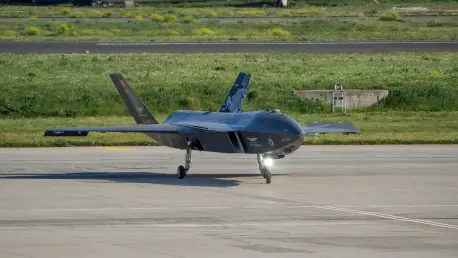Imagine a major European airport grinding to a halt, with thousands of passengers stranded and flights canceled, all because of a tiny, unauthorized drone hovering nearby, as happened at Munich Airport earlier this year. There, 17 flights were canceled and 15 diverted due to drone sightings, impacting nearly 3,000 travelers. Such incidents are no longer rare anomalies but a growing menace to aviation safety and operations across the continent. This roundup dives into the escalating threat of drone disruptions, gathering insights from industry experts, legal professionals, and security analysts to assess whether aviation insurers are equipped to handle these unique risks. The purpose is to explore diverse perspectives on operational, financial, and security challenges while uncovering potential solutions for an industry at a critical crossroads.
Unpacking the Drone Threat in Modern Aviation
The rapid proliferation of drone technology has transformed the aviation landscape, creating both opportunities and significant hazards. Industry observers note that drones, once seen as mere hobbies, now pose a serious threat near airports and critical infrastructure. Recent disruptions in countries like Denmark and Norway have exposed how even brief sightings can paralyze operations, with Copenhagen Airport suspending flights for four hours on a single day, affecting 20,000 passengers. These events underscore a shift from minor inconvenience to major operational crises, demanding attention from all aviation stakeholders.
Security specialists highlight that unauthorized drone activity carries implications beyond mere disruption. Many point to a troubling pattern of airspace violations near military bases alongside civilian hubs, suggesting possible coordinated intent. This dual threat amplifies the urgency for robust countermeasures, as the line between nuisance and strategic risk blurs. The consensus among analysts is that the aviation sector must prioritize understanding these evolving dangers to mitigate their impact effectively.
A key focus for this discussion is the readiness of insurance frameworks to address the financial fallout of such incidents. Experts across the board agree that traditional policies fall short in covering non-physical losses, leaving airlines and airports vulnerable. This roundup aims to synthesize varying viewpoints on how insurers can adapt, alongside the broader policy and technological shifts needed to safeguard the industry against drone-related risks.
Navigating the Complex Risks of Drone Incursions
The Ripple Effect of Drone Sightings on Airport Operations
Drone sightings have proven to be a logistical nightmare for airports, with cascading effects on schedules and passenger experiences. At Munich Airport, a single incident led to hours of chaos, stranding thousands overnight as flights were grounded or rerouted. Similar disruptions in Oslo, where a three-hour closure occurred on the same night as Copenhagen’s suspension, reveal the scale of impact across regions, often with little warning or immediate resolution in sight.
Aviation managers argue that the unpredictability of these events complicates response strategies. While some advocate for stricter airspace monitoring to deter operators, others believe that public awareness campaigns could reduce accidental incursions by hobbyists. These differing approaches highlight a lack of unified protocol, with airports often left to manage the fallout—ranging from passenger compensation to rescheduling—on their own terms.
The operational burden also extends to airlines, which face significant costs from delays and diversions. Industry voices stress that without a clear framework for handling such crises, the strain on resources intensifies. There’s a growing call for collaborative efforts between airports and regulatory bodies to establish standardized responses, ensuring that the chaos caused by drones doesn’t become an unmanageable norm.
Financial Blind Spots in Current Insurance Models
Traditional aviation insurance policies are often ill-suited to address the unique losses from drone disruptions, particularly when no physical damage occurs. Legal professionals in the field emphasize that business interruption claims typically require tangible harm, a condition unmet in most drone sighting cases. This gap leaves stakeholders exposed to substantial financial hits, from canceled flights to operational downtime.
Some insurance experts suggest that the industry must rethink coverage models to include indirect costs like passenger compensation and logistical rerouting. They argue that insurers need to develop tailored products that recognize the non-physical nature of drone-related losses. However, others caution that such innovations could drive up premiums, placing additional pressure on already tight budgets for airlines and airports.
The challenge of attributing liability further complicates the financial landscape. Without clear identification of drone operators, claims processes stall, leaving affected parties without recourse. Industry analysts note that bridging this gap requires not only policy updates but also technological advancements to track and penalize unauthorized drone activity, ensuring that financial protections align with real-world risks.
Security Concerns and the Specter of Hybrid Threats
Beyond operational woes, drone incursions raise alarming security questions, with some officials pointing to potential hybrid attacks targeting both civilian and military infrastructure. In Denmark, repeated sightings near sensitive facilities prompted warnings of coordinated threats, leading to heightened NATO surveillance and deployment of defense assets. This escalation signals a geopolitical dimension that the aviation sector may be underestimating.
Security analysts differ on the primary focus of response efforts. While some urge a concentration on protecting critical infrastructure through advanced detection systems, others argue that the broader implications of state-sponsored or malicious drone use demand international cooperation. This divergence reflects the complexity of addressing risks that span both local safety and global security concerns.
The aviation industry’s current emphasis on operational recovery might overshadow these strategic threats. Experts caution that failing to integrate security considerations into planning could leave airports vulnerable to more severe disruptions. There’s a pressing need for a balanced approach that tackles immediate interruptions while preparing for the possibility of orchestrated incursions with far-reaching consequences.
Evolving Drone Technology and the Race to Keep Up
The increasing sophistication and accessibility of drones fuel a surge in airspace violations across Europe, challenging existing safeguards. Technology specialists note that modern drones can evade detection with ease, outpacing many current counter-drone systems. Historical disruptions, such as the 2018 London Gatwick incident that canceled 1,000 flights over 33 hours, demonstrate that progress in mitigation has lagged behind drone advancements.
Country-specific responses to this technological race vary widely. While some nations invest heavily in counter-drone tools like signal jamming and interception systems, others struggle with regulatory delays and funding constraints. Industry observers argue that this inconsistency creates uneven protection levels, leaving certain regions more exposed to recurring incidents.
A common critique is that both regulations and tools remain reactive rather than proactive. Many experts believe that anticipating future drone capabilities—such as enhanced autonomy or stealth features—is critical for staying ahead. They advocate for insurers and policymakers to collaborate on forward-thinking strategies, ensuring that the aviation sector isn’t perpetually playing catch-up with rapidly evolving threats.
Key Insights and Steps Forward for Aviation Insurance
This roundup reveals a stark reality: drone disruptions create interconnected operational, financial, and security challenges that the aviation insurance industry is not fully prepared to address. Insights from legal and industry professionals point to a glaring gap in coverage for non-physical losses, with many policies failing to account for the indirect costs of downtime and diversions. Simultaneously, security analysts warn of broader risks, urging a shift from purely reactive measures to comprehensive threat assessment.
Actionable strategies emerge from these discussions, including the urgent need to revise insurance frameworks to encompass non-tangible impacts. Experts also recommend that the industry invest collectively in counter-drone technologies, viewing them as a shared priority rather than an individual burden. Such systems could reduce the frequency and impact of incursions, providing a buffer for insurers to develop more relevant products.
For stakeholders, practical steps involve advocating for clearer liability laws to streamline claims and partnering with technology firms to enhance detection and response capabilities. Some suggest forming cross-sector alliances to pool resources and expertise, ensuring that airports, airlines, and insurers tackle these risks holistically. These collaborative efforts could pave the way for a more resilient aviation ecosystem, better equipped to handle drone-related disruptions.
The Future of Aviation in a Drone-Dominated Era
Looking back, this exploration of drone disruption risks through varied expert lenses paints a picture of an industry grappling with multifaceted threats. The insights gathered from operational, financial, and security perspectives underscore a critical need for adaptation. Insurers, airports, and governments face a steep learning curve as they navigate uncharted territory, with incidents across Europe serving as stark reminders of their vulnerabilities.
Moving forward, the aviation sector must commit to innovative solutions, such as integrating advanced counter-drone systems into standard operations over the next few years, from this year to 2027. Establishing international protocols for drone threat response could further strengthen defenses, while insurers might explore pilot programs for non-physical loss coverage to test new models. These steps, combined with ongoing dialogue among stakeholders, offer a path toward safeguarding airspace and ensuring stability in an era increasingly defined by drone challenges.









